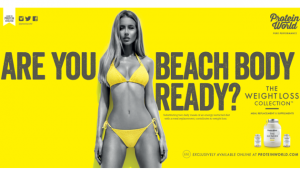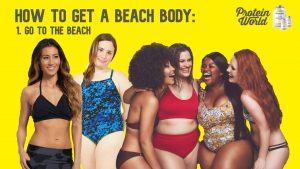
Please see the Google Drive Link: https://drive.google.com/file/d/1KjX8v1t3qFcbKGuNgX9QiyyUH0mtDxP6/view?usp=sharing
Imagine that it’s a rainy evening in London in 2015 and you are in the subway, waiting for the next train. You walk past a bright, glaring yellow ad on the walls – a thin, young, blonde woman in a yellow swimsuit stares back at you with the bold words “Are You Beach Body Ready?”. I wanted to tackle the narrow representation of women in advertising, within the GRSJ contexts of intersectionality (what is missing in media’s portrayal of “female”) with the lack of ethnic diversity. Protein World markets a weight-loss meal replacement product, targeted to women aspiring to have an “athletic” figure. Despite previous backlash regarding setting unrealistically thin body standards for women, the Chief Marketing Officer defended it and said they will “continue [their] fight against the global obesity epidemic as [they] strive to make the world leaner, fitter, healthier, and stronger”[1]. However, the displayed ideal is not realistic since fit people, despite having a very healthy lifestyle, may not necessarily be “thin yet curvy”. Athleticism is dependent on muscle, healthy BMI, bone structure, and height – the model’s body is an example of commercialism trying to create a sense of desire to achieve this “ideal body type” by looking like the young, attractive white model and for the viewers of the ad in order to sell the product.
Aside from the product, the traditional norm in the advertising industry is to select models who are young, white, and with socially desirable traits (in this case, a “fit” or “slim” body). In addition, there are undertones of the historical context of using women in order to sell products (i.e. the phrase “sex sells”), which give clues as to the roles of women in society (i.e. being objectified and portrayed as passive rather than being empowered as individuals). Visibility is more important than ever beyond this narrow portrayal of women, especially being based in London, with immigration, ethnic, and cultural diversity comparable to North America, where GRSJ’s context and focus is in.

I had a primary goal and a secondary goal – first, to increase the degree of diversity by broadening the scope of females in society such as women of colour and trans women, and second, to portray “healthy” women in a realistic manner. This is especially important because of the focus on advertisements featuring young, cis, white, middle/middle-upper class women. Similarly, this “young, white, middle class” focus also applied to past feminist waves in GRSJ.
Here, the women are confident, embracing themselves, and empowered as individuals rather than having their bodies on display and being objectified to market a product. The new caption is a tongue-in-cheek, impactful message of acceptance and diversity.
To address the CMO’s comment regarding promoting health, I redefined what it meant to be at a healthy weight – women could be muscular, athletic, curvy, plus-size, or thin, as long as they are still pursuing a healthy lifestyle, nonetheless. Although it was a weight loss product, I shifted the focus away from the “thin yet curvy” model proportions and instead redirected it towards portraying women who are healthy and strong instead.
My aim was to tackle the portrayal of women in advertisements and create a more realistic picture of who is female – whether through race/ethnicity, or through identity. I was partially inspired by Sephora’s latest campaign, “We Belong to Something Beautiful” which I have been seeing in SkyTrain stations downtown. Sephora aimed to increase representation for trans women and women of colour within the context of gender fluidity, trans, and non-binary communities[2].
The personal is political in two ways – one, only very few women can identify and see themselves in the model in the original advertisement, and two, many women can see the undertone of objectifying female models in order to make a product desirable in marketing, especially with connotations of what it means to be a woman in society (passive “objects” rather than empowered individuals), and the body expectations that come along with it.
[1] Graham, L. (2015, July 1). Protein World’s Beach Body Ready ad ‘not offensive’: Watchdog. Retrieved from https://www.cnbc.com/2015/07/01/protein-worlds-beach-body-ready-ad-not-offensive-watchdog.html
[2] Pasquarelli, A. (2019, June 4). Sephora pushes fluid identity in new campaign. Retrieved from https://adage.com/creativity/work/sephora-identify-we/2175266